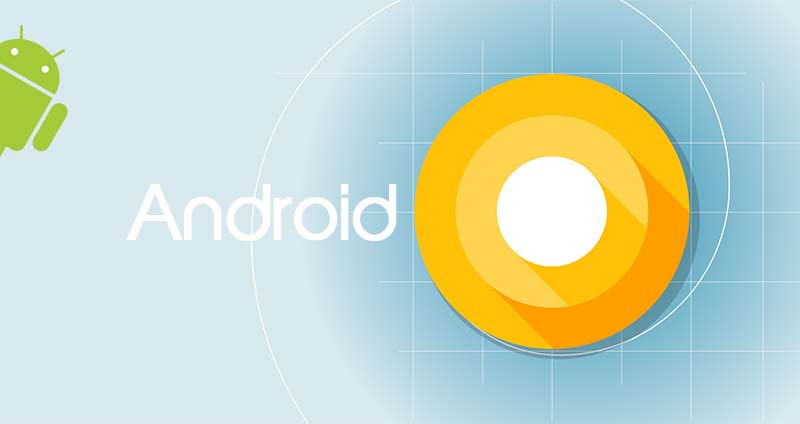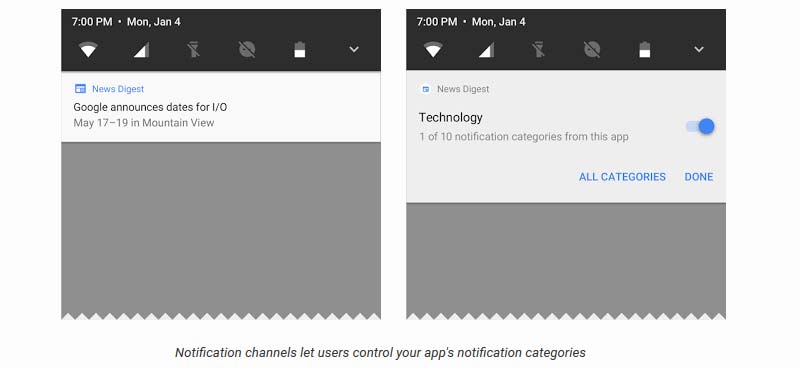Google has released the first “Developer Preview” of Android O, the next major version of its popular mobile operating system.

The Developer Preview is in its early days, there are more features coming, and there’s still plenty of stabilization and performance work ahead. Google will provide a complete intro of this new operating system at the upcoming Google I/O in May, however many of the key features are revealed in a blog post.
What’s New in Android O?
Android O introduces a number of new features and APIs for developers that includes:
Background limits:
Android O puts a big priority on improving a user’s battery life and the device’s interactive performance. Additional automatic limits are applied on what apps can do in the background, in three main areas: implicit broadcasts, background services, and location updates.
These changes will make it easier to create apps that have minimal impact on a user’s device and battery.
Notification channels:
Android O also introduces notification channels, which are new app-defined categories for notification content.
Channels let developers give users fine-grained control over different kinds of notifications — users can block or change the behavior of each channel individually, rather than managing all of the app’s notifications together.

Android O also adds new visuals and grouping to notifications that make it easier for users to see what’s going on when they have an incoming message or are glancing at the notification shade.
Autofill APIs:
Android O adds platform support for autofill, so users can select an autofill app, similar to the way they select a keyboard app.
The autofill app stores and secures user data, such as addresses, user names, and even passwords.
PIP for handsets and new windowing features:
Picture in Picture (PIP) display is now available on phones and tablets, so users can continue watching a video while they’re answering a chat or hailing a car. Apps can put themselves in PiP mode from the resumed or a pausing state where the system supports it – and you can specify the aspect ratio and a set of custom interactions (such as play/pause).
Font resources in XML:
Fonts are now a fully supported resource type in Android O. Apps can now use fonts in XML layouts as well as define font families in XML — declaring the font style and weight along with the font files.
Adaptive icons:
Developers can now create adaptive icons that the system displays in different shapes, based on a mask selected by the device. The system also animates interactions with the icons, and uses them in the launcher, shortcuts, Settings, sharing dialogs, and in the overview screen.
![]()
![]()
Wide-gamut color for apps:
Android developers of imaging apps can now take advantage of new devices that have a wide-gamut color capable display. To display wide gamut images, apps will need to enable a flag in their manifest (per activity) and load bitmaps with an embedded wide color profile (AdobeRGB, Pro Photo RGB, DCI-P3, etc.).
Connectivity:
For the ultimate in audio fidelity, Android O now also supports high-quality Bluetooth audio codecs such as LDAC codec. We’re also adding new Wi-Fi features as well, like Wi-Fi Aware, previously known as Neighbor Awareness Networking (NAN). On devices with the appropriate hardware, apps and nearby devices can discover and communicate over Wi-Fi without an Internet access point.
Keyboard navigation:
In Android O Google, focused on building a more reliable, predictable model for “arrow” and “tab” navigation that aids both developers and end users.
AAudio API for Pro Audio:
AAudio is a new native API that’s designed specifically for apps that require high-performance, low-latency audio. Apps using AAudio read and write data via streams.
WebView enhancements:
In Android O, multiprocess mode is enabled by default and adding an API to let your app handle errors and crashes, for enhanced security and improved app stability. As a further security measure, you can now opt in your app’s WebView objects to verify URLs through Google Safe Browsing.
Java 8 Language APIs and runtime optimizations:
Android now supports several new Java Language APIs, including the new java.time API. In addition, the Android Runtime is faster than ever before, with improvements of up to 2x on some application benchmarks.
Partner platform contributions: Hardware manufacturers and silicon partners have accelerated fixes and enhancements to the Android platform in the O release. For example, Sony has contributed more than 30 feature enhancements including the LDAC codec and 250 bug fixes to Android O.

Download Android O on Your Phone:
If you’re a developer and interested in checking Android O, Google has launched a new Android O Developer Preview site offering details on its planned timeline for development, behavior changes in the new version, and new APIs.






